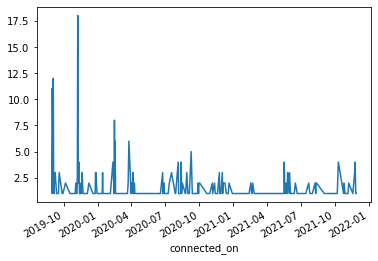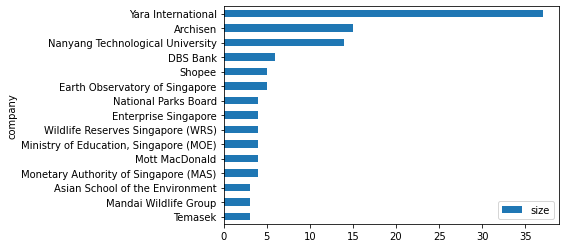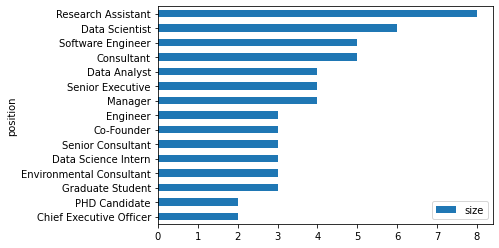
LinkedIn Network Analysis
2021, Dec 01
Visualise my LinkedIn Social network using networkx and plotly to improve my understanding on network and graphy theories.
## Installing Libraries
import numpy as np
import pandas as pd
import networkx as nx
from pyvis import network as net
import janitor
import plotly.express as px
%matplotlib inline
import matplotlib.pyplot as plt
import seaborn as sns
from IPython.core.display import display, HTML
## Loading dataset
df = pd.read_csv('data/Connections.csv',skiprows=2)
df.info() # summary info
<class 'pandas.core.frame.DataFrame'>
RangeIndex: 400 entries, 0 to 399
Data columns (total 6 columns):
# Column Non-Null Count Dtype
--- ------ -------------- -----
0 First Name 397 non-null object
1 Last Name 397 non-null object
2 Email Address 7 non-null object
3 Company 390 non-null object
4 Position 390 non-null object
5 Connected On 400 non-null object
dtypes: object(6)
memory usage: 18.9+ KB
At a quick glance, I have about 400 connections.
Data Cleaning
I will perform some cleaning, remove unnecessary attributes and remove null values from the data.
new_df = (
df.clean_names() # remove spacing and capitalisation
.drop(columns=['first_name','last_name','email_address']) # dropped first, last and email
.dropna(subset=['company','position']) # remove null values in company and position
.to_datetime('connected_on', format='%d %b %Y') # convert date column to datetime object
)
new_df.head()
| company | position | connected_on | |
|---|---|---|---|
| 0 | InfoCepts | Talent Acquisition Lead | 2021-11-28 |
| 1 | Yara International | Associate data engineer | 2021-11-27 |
| 2 | Yara International | Lead Recruiter, Digital Ag Solutions | 2021-11-25 |
| 3 | Yara International | Data Scientist | 2021-11-25 |
| 4 | Yara International | Associate Digital Information Specialist | 2021-11-25 |
Data Exploration
- Connnections at a glance
- New connections over time
- Top 15 companies my connections work at
- Top 15 roles my connections work as
Connections at a glance
new_df1 = new_df[['company','position']]
new_df1['My Network'] = 'My Network'
px.treemap(new_df1, path=['My Network', 'company', 'position'], width=1200, height=1200)

New Connections over time
daily_connections = (new_df
.groupby(by=['connected_on']) # group by date
.size() # sum up new connections per day
.plot() # plot line chart
)

Looking at the number of new connections over time since i joined LinkedIn, bulk of my connections were created during the start - period between end 2019 and start of 2020).
Top 15 companies my connections work at
companies_count = (new_df
.groupby(by=['company']) # group by country
.size() # sum up count for each company
.to_frame('size') # convert to frame
.sort_values(by=['size'],ascending=False) # sort by descending order
.reset_index()
)
companies_count.head(15).plot(kind='barh').invert_yaxis() # convert to horizontal plot

Top 15 roles my connections are working in
position_count = (new_df
.groupby(by=['position']) # group by country
.size() # sum up count for each company
.to_frame('size') # convert to frame
.sort_values(by=['size'],ascending=False) # sort by descending order
)
position_count.head(15).plot(kind='barh').invert_yaxis() # convert to horizontal plot

The top 3 companies my connections are working in are from Yara, Archisen and NTU, which is expected given that I did my undergraduate degree in NTU, worked at Archisen after graduation before joining Yara International.
Most of my connections are Research Assistants, Data Scientist and Software Engineers.
Network Analysis
companies_count.reset_index(inplace=True,drop=True)
companies_count_reduced = companies_count.loc[companies_count['size'] >=2]
print(companies_count_reduced.shape)
(42, 2)
position_count.reset_index(inplace=True)
position_count_reduced = position_count.loc[position_count['size'] >=2]
print(position_count_reduced.shape)
(35, 2)
# Initialise Graph
g1 = nx.Graph()
g1.add_node('root') # initialising myself as centrala node
#
for id,row in companies_count_reduced.iterrows():
# store company name and count
company = row['company']
count = row['size']
title = f"<b>{company}</b> - {count}"
# extract the positions my connections hold and store them in a set to prevent duplication
positions = set([x for x in new_df[company == new_df['company']]['position']])
positions = ''.join('<li>{}</li>'.format(x) for x in positions)
position_list = f"<ul>{positions}</ul>"
hover_info = title + position_list
g1.add_node(company, size = count*2, title = hover_info, color='#3449eb')
g1.add_edge('root',company,color='grey')
# Generate the graph
company_nt = net.Network(height='700px', width='700px', bgcolor="grey", font_color='white',notebook=True)
company_nt.from_nx(g1)
company_nt.hrepulsion()
company_nt.show('company_graph.html')
display(HTML('company_graph.html'))
# initialize graph
g2 = nx.Graph()
g2.add_node('root') # intialize yourself as central
# use iterrows tp iterate through the data frame
for id, row in position_count_reduced.iterrows():
count = f"{row['size']}"
position= row['position']
g2.add_node(position, size=count, color='#3449eb', title=count)
g2.add_edge('root', position, color='grey')
# generate the graph
position_nt = net.Network(height='700px', width='700px', bgcolor="black", font_color='white', notebook = True)
position_nt.from_nx(g2)
position_nt.hrepulsion()
position_nt.show('position_graph.html')
display(HTML('position_graph.html'))